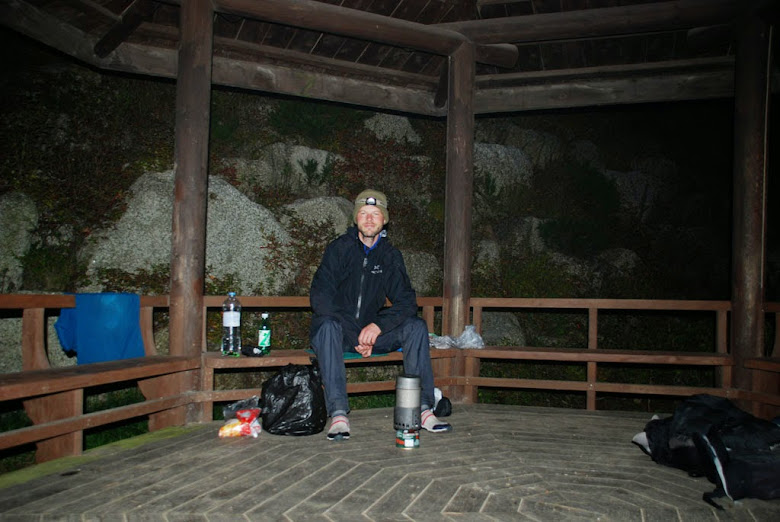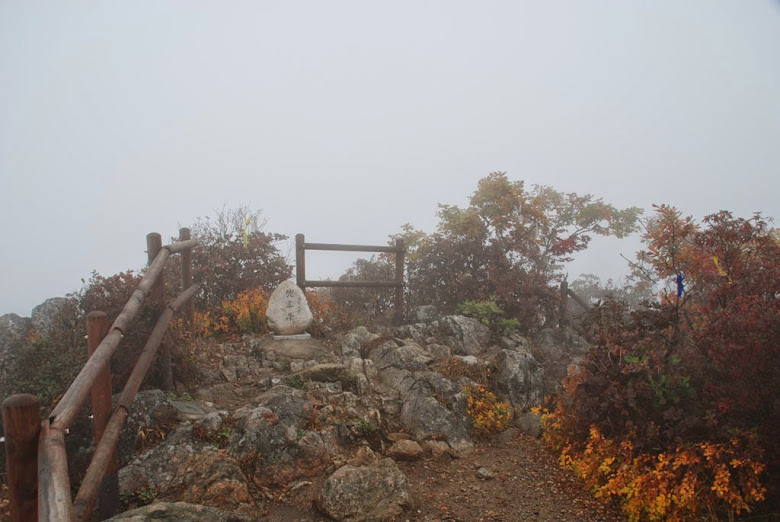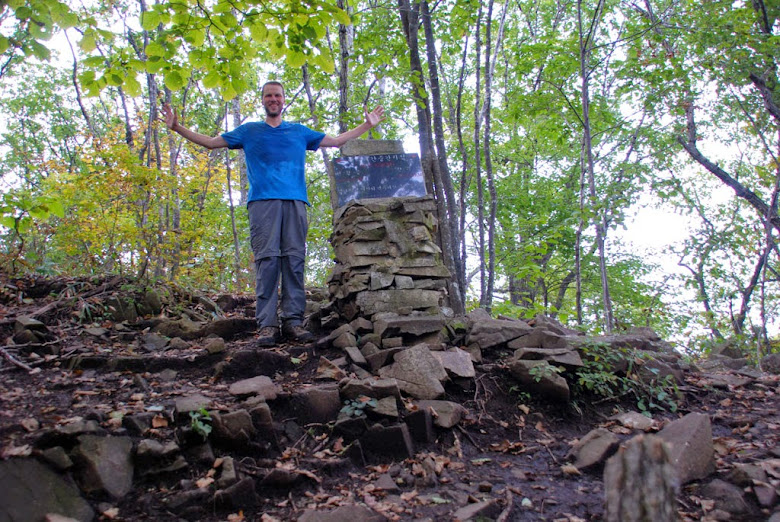Distance: 24.0km (434.9km), time spent: 9:53 (224:29).
Altitude (start / end / highest): 689m / 782m / 1439m.
Weather: Sunny, foggy, overcast.
High expectations are usually difficult to live with; bringing them along on a walk could also make things difficult. That can easily lead to disappointment. Between Jukryeong and Gochiryeong, the trail passes through the very heart of Sobaeksan National Park, and has been a stage that I have been looking forward to for a long time. Here the Baekdudaegan goes over an open ridge with views to both sides, through fields of azaleas that blooms pink in the spring. There is little I can do to see the azaleas blossoming, for that I am here at the wrong time of the year, but I will rejoice walking in an open landscape.
Warm sunlight over the landscape below the mountain, from a viewing platform on the way up towards 2. Yeonhwabong in the morning.
When I look out of the window early in the morning however, there is not much indication of an open landscape, even in the dark I can see that the fog is lying thick around the pass. I am setting forth at 6 o'clock, which is the earliest time I have started walking on the journey so far. My spirits are a little low in the start, when I walk up the seven kilometres long road in the beginning of the trail, where the Sobaeksan Optical Astronomy Observatory periodically has placed a series of installations of heavenly bodies next to the road. Outside the solar observatory itself stands the Earth, at the summit of Yeonhwabong is the Sun shining.
Below Sobaeksan the landscape is a waving sea of clouds.
Leading the way up from the foggy pass is the solar system. The sky changes colour from grey to blue, through the trees the early rays from the sun can be seen. And from a viewing platform, the sun are bathing the landscape below the mountain in warm sunlight. I stand for a long time at the place, enjoying the view, enjoying it while I can. Rather confusing they have given three of the summits here the same name, Yeonhwabong. The trail goes around 2. Yeonhwabong (1357m), I do not walk up to the summit itself. Which I regret afterwards. Below me is a waving sea of clouds, which the green ridges are rising up from. Saturn is located next to another viewing platform; in the horizon, I can see Birobong and Gukmangbong.
View back from Yeonhwabong, below lies the solar observatory and in the background is 2. Yeonhwabong.
At the summit of Yeonhwabong (1383m), I have passed by Mars, the solar observatory and the Earth. I stand next to the Sun beneath the light from the proper Sun in the sky, in the horizon in front of me lies the open ridge of Sobaeksan tempting under the blue sky. But the Sun is left behind at Yeonhwabong, from the summit the path descends down into a nice wooden section, where the autumn colours are starting to bear fruits. And returns up again to a landscape in movement, the sea of fog has started to move. Before 1. Yeonhwabong (1394m) clouds are rolling over the mountain.
A viewing platform with an installation of the Sun at the summit of Yeonhwabong. In the background, the open ridge the trail goes over in Sobaeksan.
And here where there is a blossoming sea of flowers in the spring, there is now a blossoming sea of fog. For a little while, I am frustrated, and a little bit disappointed. Then I take a deep breath and swallows the disappointment, even though there is not a view to be had, the walk is quite cool. The fenced in trail disappears into the maw of the fog, small trees and bushes emerges along the path as crippled figures. It does not rain, but it is a little bit gusty. On a side path, a small cabin materializes itself from the mist, nothing inside the cabin, but a good enough time to sit down and have a break.
After Yeonhwabong, the path disappears down into the woods, where autumn colours are starting to show.
From the little hut, there is a short way up through the clouds to Birobong (1439m), the highest summit in the national park. The plateau at the top is fenced in, with a large doltap and several monuments of stone resting on the ground. And it is also the first place where I meet other people today. A young couple from Germany on a round trip in South-Korea are here, they have climbed up from the Birosa-temple, we talk together for a while before we continues in our separate ways. They down again to the temple, and I over an open ridge with a small sign that the clouds are lifting. The fog is not lying so thick over the alpine grass now.
In the springtime you walk here through a blossoming sea of azaleas, now the trail goes through a blossoming sea of fog on both sides of the open ridge.
The path are after a while leaving the rubber-cover on the ground, which is put down on the path so the hikers does not damage the vegetation, I have been walking on through most of Sobaeksan. Red hues are appearing on the leaves, more of the valley floors below are visible. At Gukmangbong (1420m), I eat lunch amongst the boulders at the top. The disappointment has left my body, changed into a joy of walking in a landscape I have been looking forward to. In the book, there was a picture from the path going from Gukmangbong, a walk that appeared to be going over what looked like a desolate moor, something in me wanted to experience the same thing. Since the clouds now has climbed further up towards the sky, I get to do exactly that. I wander if Prince Maui, son of King Gyeongsun of the Silla kingdom, felt the same way when he was standing on the summit on his flight to Geumgangsan.
Below Birobong, this small cabin emerged out of the mist.
Then the Baekdudaegan leaves the parade street through Sobaeksan and moves down into the forest. The embrace of the fog are changed to the embrace of the woods. The last stretch before Gochiryeong, past the Neujeunmaegijae and Madangchi passes, is a long and pleasant walk through a more familiar sight on the journey. At Gochiryeong, it is quiet; a light wind blows around the sanshingak and the jangseung-poles there.
At the summit of Birobong, no views.
I pitch my tent on the helipad above the pass, among buzzing wasps. Water is located a little down on the north side of the pass, where someone has left behind a bag of candy next to the water source. I take my chance and both eat something of the candy and drink of the water. For dinner, I eat one of the Korean combat rations I bought at Jukryeong. It contains rice, vegetables and meat; it tastes good enough, but there could have been more meat.
Leaving Gukmangbong, over a desolate landscape, the dense layer of clouds has climbed higher up on the sky.
When I sit and relax here in Gochiryeong, the little frustration I had underway has been forgotten. Instead, this has been one of the best days of my walk so far. But the early morning and varied walk through Sobaeksan has made its mark, satisfied I let the Sandman come on a visit at half past eight.
Inside the sanshingak at Gochiryeong.
<- JukryeongBuseoksa ->






















































